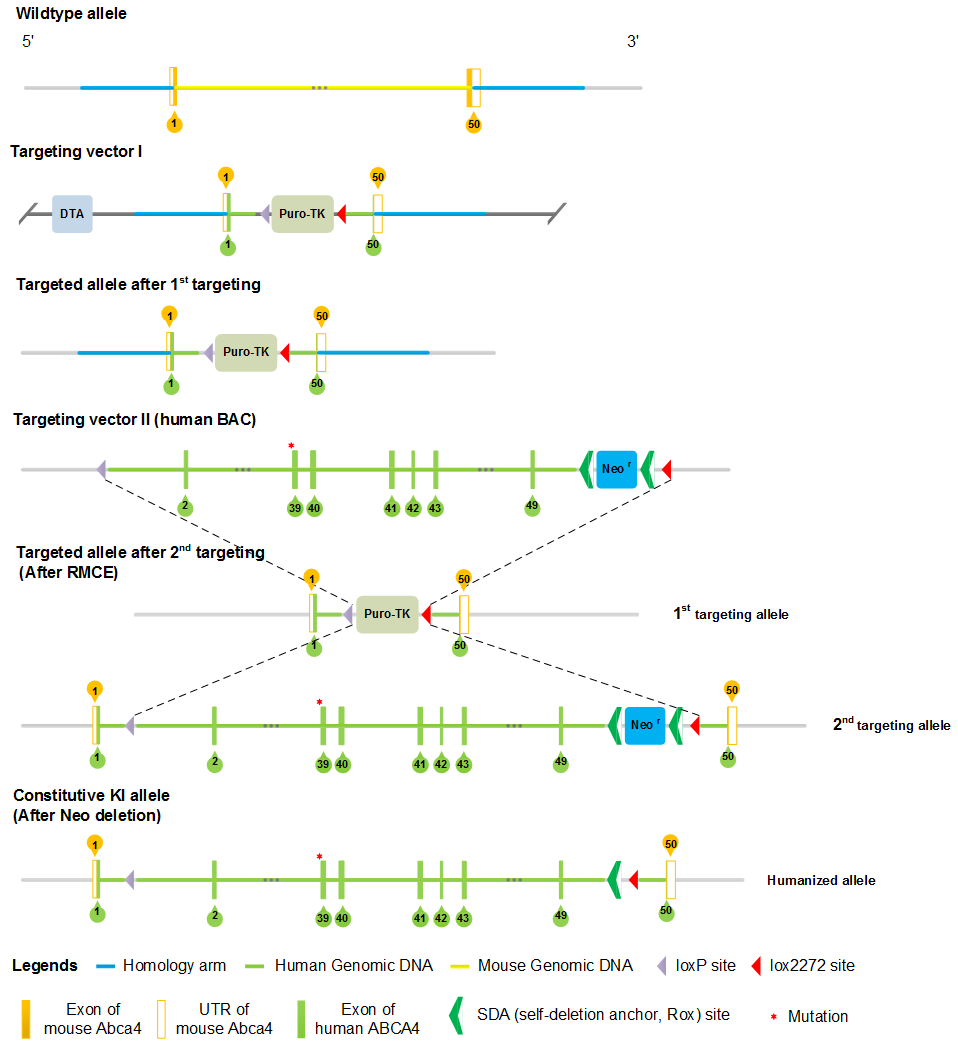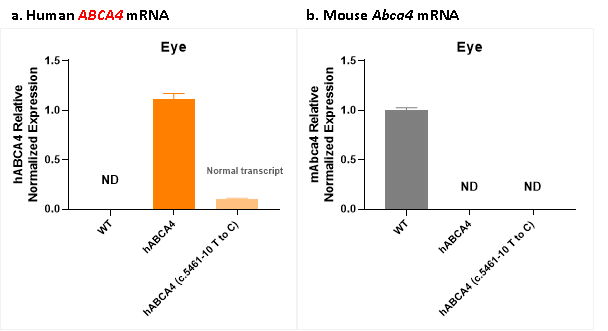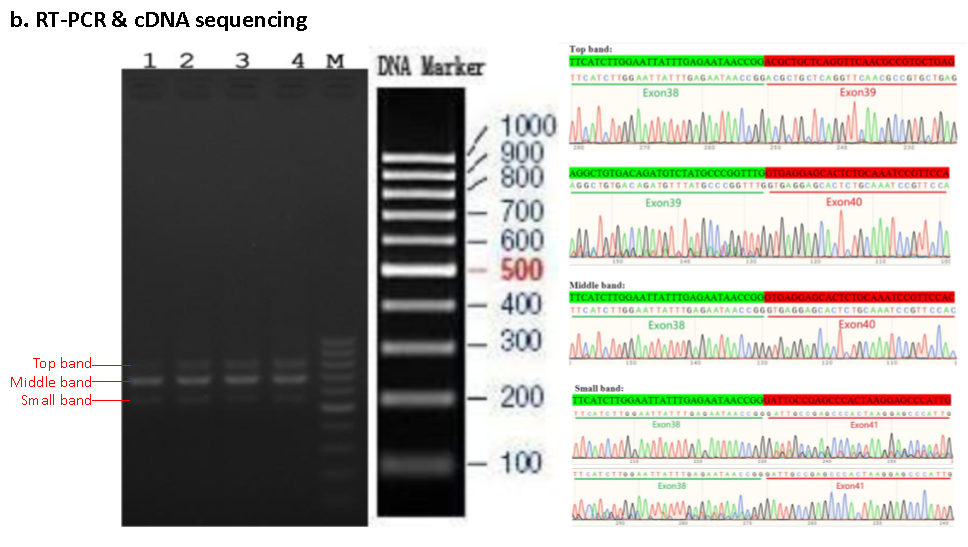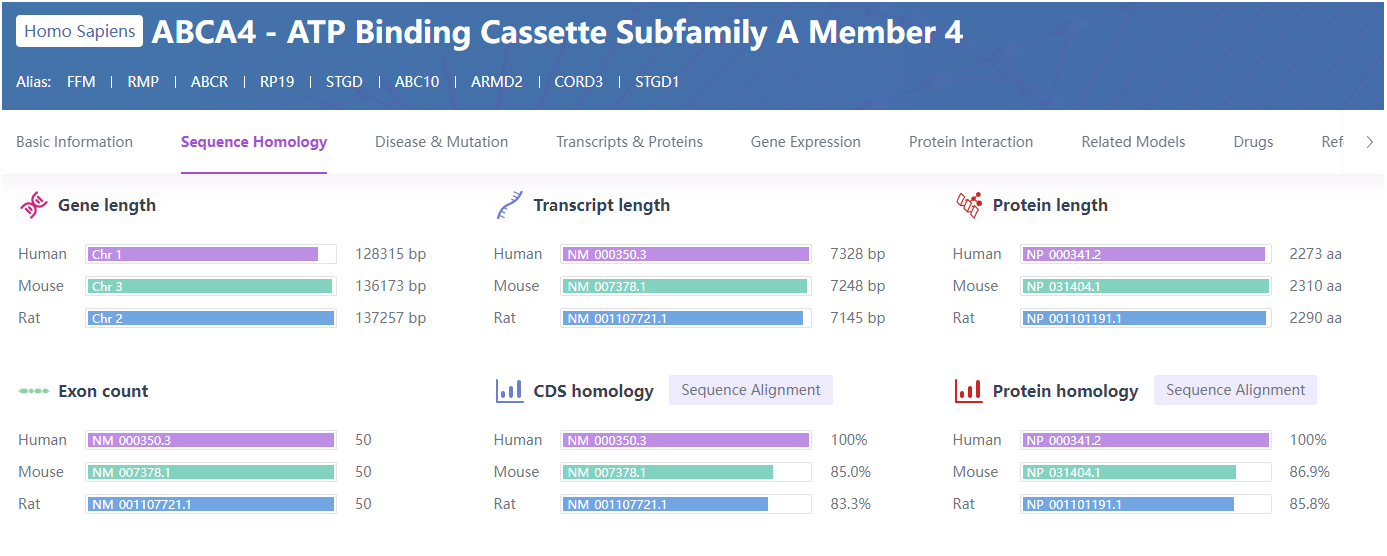

Catalog Number: I001210
Strain Name: C57BL/6JCya-Abca4tm1(hABCA4*c.5461-10T>C)/Cya
Genetic Background: C57BL/6JCya
One of Cyagen's HUGO-GT™ (Humanized Genomic Ortholog for Gene Therapy) Strains
Strain 설명
Stargardt Disease (STGD) is a hereditary macular dystrophy marked by yellowish fusiform spots in the retinal pigment epithelium, leading to macular atrophy. It primarily affects children and adolescents, causing progressive central vision loss and mild color vision impairment. The fundus may show pale yellow lesions with gold foil-like reflections and yellow-white spots around the posterior pole. Advanced stages involve atrophy of the retinal pigment epithelium, photoreceptor cells, and choriocapillaris. STGD is also common in sporadic cases and more frequent in children of consanguineous marriages. It affects both eyes bilaterally and progresses synchronously without significant gender differences, with an incidence of approximately 1/8000 to 1/13000. STGD is an autosomal recessive retinal disease caused by ABCA4 gene mutations, accounting for 95% of cases.
The ABCA4 gene encodes a retina-specific ABC transporter protein that removes retinal derivatives and toxic metabolites after rhodopsin photobleaching. Mutations in ABCA4 lead to the accumulation of these substances, causing apoptosis of retinal pigment epithelial and photoreceptor cells, resulting in retinal degenerative diseases. ABCA4 mutations are linked to Stargardt Disease (STGD), Cone-rod Dystrophy (CRD), and Retinitis Pigmentosa (RP). The clinical phenotype depends on the extent of ABCA4 mutations, with severe and mild mutations or two moderate mutations predisposing to STGD, and one moderate mutation predisposing to CRD.
Currently, the drug pipeline for treating Stargardt disease (STGD) primarily focuses on supplemental delivery methods for ABCA4-targeted drugs. Among them, ProQR has developed a therapeutic antisense oligonucleotide (ASO) drug, QR-1011, which targets the c.5461-10T>C mutation [1]. Most ASO medicines and gene therapies act on the human ABCA4 gene. Considering the genetic differences between animals and humans, modifying mouse genes to be more human-like would help accelerate gene therapies targeting ABCA4 into the clinical stage.
The B6-hABCA4*c.5461-10T>C mouse is a humanized model of the Abca4 gene, where the mouse Abca4 gene has been replaced with the human ABCA4 gene carrying the c.5461-10T>C mutation using gene editing technology. This model can be used for research on various retinal degeneration diseases such as Stargardt disease (STGD), cone-rod dystrophy (CRD), and retinitis pigmentosa (RP). In addition, based on the independently developed TurboKnockout fusion BAC recombination technology, Cyagen can also provide customized services for specific mutations to meet the experimental needs in pharmacology and other fields.
Strain 유전자 편집 전략

Figure 1. Gene editing strategy of B6-hABCA4*c.5461-10T>C mice. The sequences from the ATG start codon to the TGA stop codon of the mouse Abca4 gene will be replaced with the sequences from the ATG start codon to the TGA stop codon of the human ABCA4 gene. The c.5461-10 T to C point mutation was introduced into intron 38 of human ABCA4.
응용 분야
검증 데이터
1. Expression of human ABCA4 and mouse Abca4 genes

Figure 2. Detection of human ABCA4 and mouse Abca4 gene expression in the eyes of 4-week-old female B6-hABCA4*c.5461-10T>C mice, B6-hABCA4 mice, and wild-type (WT) mice. RT-qPCR result shows significant expression of the human ABCA4 gene in the eyes of B6-hABCA4 mice and B6-hABCA4*c.5461-10T>C mice carrying the point mutation. The humanized models do not express the mouse Abca4 gene, while only the mouse Abca4 gene is expressed in wild-type mice (ND: Not detected).
*The c.5461-10T>C mutation can cause splicing defects, leading to reduced full-length mRNA in patient fibroblasts and skipping of exons 39–40. Compared to the non-mutant control group, reduced levels of full-length ABCA4 protein can be observed [4].
2. Sequencing of ABCA4 cDNA


Figure 3. Sequencing results of the region from exon 38 to exon 41 of the human ABCA4 gene in B6-hABCA4*c.5461-10T>C mice. Using primers specifically paired with human ABCA4 mRNA, reverse transcription was performed to amplify cDNA, followed by gel electrophoresis to determine the expression of the human ABCA4 gene. Result shows that three types of human ABCA4 cDNA bands (Normal mRNA, Exon 39 skipped mRNA, and Exons 39-40 skipped mRNA) were present in the eye tissue of B6-hABCA4*c.5461-10T>C mice, with band types and sizes matching the expected patterns. Sequencing analysis of ABCA4 cDNA reveals that exons 38 to 41 of the mouse Abca4 gene in B6-hABCA4*c.5461-10T>C mice were successfully replaced by exons 38 to 41 of the human ABCA4 gene carrying the c.5461-10T>C mutation, resulting in the expected three distinct transcripts.
추가 정보: The Rare Disease Data Center (RDDC)
1. Basic information about the ABCA4 gene

https://rddc.tsinghua-gd.org/gene/24
2. ABCA4 clinical variants
3. Disease introduction
Stargardt Disease (STGD) is a hereditary macular dystrophy marked by yellowish fusiform spots in the retinal pigment epithelium, leading to macular atrophy. It primarily affects children and adolescents, causing progressive central vision loss and mild color vision impairment. The fundus may show pale yellow lesions with gold foil-like reflections and yellow-white spots around the posterior pole. Advanced stages involve atrophy of the retinal pigment epithelium, photoreceptor cells, and choriocapillaris. STGD is also common in sporadic cases and more frequent in children of consanguineous marriages. It affects both eyes bilaterally and progresses synchronously without significant gender differences, with an incidence of approximately 1/8000 to 1/13000. STGD is an autosomal recessive retinal disease caused by ABCA4 gene mutations, accounting for 95% of cases.
4. ABCA4 gene and mutations
The ABCA4 gene encodes a retina-specific ABC transporter protein that removes retinal derivatives and toxic metabolites after rhodopsin photobleaching. Mutations in ABCA4 lead to the accumulation of these substances, causing apoptosis of retinal pigment epithelial and photoreceptor cells, resulting in retinal degenerative diseases. ABCA4 mutations are linked to Stargardt Disease (STGD), Cone-rod Dystrophy (CRD), and Retinitis Pigmentosa (RP). The clinical phenotype depends on the extent of ABCA4 mutations, with severe and mild mutations or two moderate mutations predisposing to STGD, and one moderate mutation predisposing to CRD.
The ABCA4 gene contains 50 exons and spans approximately 128 kb of genomic DNA. It encodes a protein of 2,273 amino acids, with a molecular weight of approximately 250 kDa. Mutations in the ABCA4 gene exhibit distinct racial specificity, and compound mutations are a characteristic feature of ABCA4 gene mutations. To date, over 2,000 variants have been identified, including missense, nonsense, splicing, structural, and deep intronic variants. Missense variants account for the majority of ABCA4 variants. The most common severe pathogenic mutation is c.5461-10T>C. According to reports, this mutation has a higher frequency in South African patients [2].
5. Function of non-coding DNA sequences
The most common pathogenic mutation is a c.5461-10T>C mutation in intron 38 [3], which can cause splicing defects, leading to a reduction in full-length mRNA of fibroblasts and skipping of exons 39-40. Compared with the control group without mutations, a decrease in full-length ABCA4 protein levels can be observed. Most ABCA4 gene mutations are non-classical splicing site mutations [4].
6. ABCA4-targeted gene therapy
Current treatments for STGD primarily focus on ABCA4-targeted supplemental delivery therapies. ProQR has developed a therapeutic antisense oligonucleotide (ASO) drug, QR-1011, which targets the c.5461-10T>C mutation, using organoids carrying this mutation as a preclinical model [1]. Sanofi’s SAR422459 (EIAV-ABCA) pipeline delivers ABCA4 via a lentiviral vector system to Abca4−/− mouse models to treat STGD. While delivery therapies dominate current STGD treatments, targeting the reduction of endogenous ABCA4 mutation expression also holds promise, given the disease’s pathogenic mechanism involves ABCA4 mutations causing toxicity.
7. Summary
The ABCA4 gene is an important pathogenic gene for various retinal degenerative diseases such as Stargardt disease (STGD), Cone-rod Dystrophy (CRD), and Retinitis Pigmentosa (RP). ABCA4 humanized mice and the hotspot mutation disease model (B6-hABCA4*c.5461-10T>C mice) based on this strain from Cyagen can be used for preclinical research on STGD, CRD, and RP, and customized services can also be provided for different point mutations.
참고 문헌